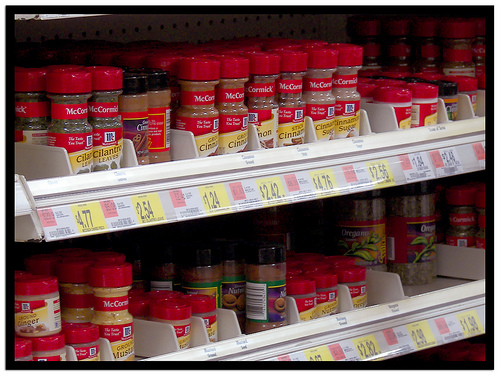The seven spices every beginner should buy

If you are recently out on your own, or have recently decided to start cooking real food, you might be perplexed by the huge array of spices available for purchase at your local grocery store. People say "cooking from scratch is so much cheaper," but they don't realize that's not the case if you have to buy each spice the recipe calls for, because you don't have any. Spices are expensive!
Food snobs will say you should only use fresh herbs, and that is true. But it's also a case where "the perfect is the enemy of the good." Fresh herbs are more expensive, don't keep well, and it's inconvenient to have to chop and prep them if all you want is something to eat for dinner on a Thursday night.
When you buy dried spices, I recommend only buying the short containers. It's tempting to go for the better value and buy a giant container. But you will never use them as quickly as you think, and you'll end up saddled with a huge tub of stale spices. (I rejoiced the day that I finished the last of the giant tub of cinnamon I bought at Costco. It took me nearly a decade to get through it.)
For maximum utility, you want to buy the spices that are used in the most number of recipes. Obviously that list will vary from person to person, and by cuisine and region. But here's a starting point, from someone who has been there.
This sounds obvious, but hear me out. One of the biggest changes you can make to improve the flavor of your cooking is to buy better salt. Sea salt is widely available in most grocery stores, and it is well worth the extra money. Buy finely ground sea salt or buy a salt grinder and grind it yourself; it doesn't much matter. (Unlike pepper, freshly-ground salt doesn't taste any better.)
After using sea salt exclusively for a few years, I bought a blue canister of table salt in a salt emergency. It didn't taste like salt to me; it tasted like chemicals. I ended up throwing the whole thing out.

2. Pepper
Fresh-ground pepper is a whole different ballgame compared to the gray dust most of us are accustomed to using at home. You can buy single-use pepper grinders in the spice aisle, they only cost a few dollars and last a long time.

Image courtesy Flickr/pabadoo
3. Thyme
Now we're getting into the "real spices." I find that I use thyme more than any other spice. Thyme is good on potatoes, chicken, pork, in broth and soups, and with tomatoes. I always sprinkle at least a little into spaghetti sauce, over roasted chicken, when making chicken or beef stock, into scrambled eggs, when roasting potatoes and over sliced tomatoes in a summer salad.

Image courtesy Flickr/kobiz7
4. Cinnamon
Speaking of cinnamon, if you have the least interest in baking, this is the #1 spice you will want to have on hand. Cinnamon is also great for perking up your morning oatmeal, or adding a little kick to a cup of hot cocoa.

Image courtesy Flickr/cbcastro
5. Vanilla
Again with the baking, vanilla is one of the few cases where I think you really do need to get "the better kind." The difference between "artificial vanilla flavor" and "real vanilla extract" is shocking; both the taste and the price. Real vanilla usually costs three or four times more than the fake stuff, but it tastes ten times better.

Image courtesy Flickr/richard_north
6. Rosemary
Rosemary has a strong, unique taste, which means that it isn't the most versatile spice. (I would say that's thyme.) But these qualities also make it fantastic for several basic recipes that are good for beginning cooks, and more experienced cooks with little time to spare.

Image courtesy Flickr/Nick Heer
7. Italian Seasoning
This is another short cut that would make "real cooks" gasp in horror, but you and I, we live in the real world. And let me tell you, the Italian seasoning blend is usually pretty good.
I have a container from McCormick that includes marjoram, thyme, rosemary, savory, sage, oregano, and basil. I use it whenever I'm making anything Italian, which for me basically means Bolognese sauce. It's the most delicious short cut I have!


3 comments